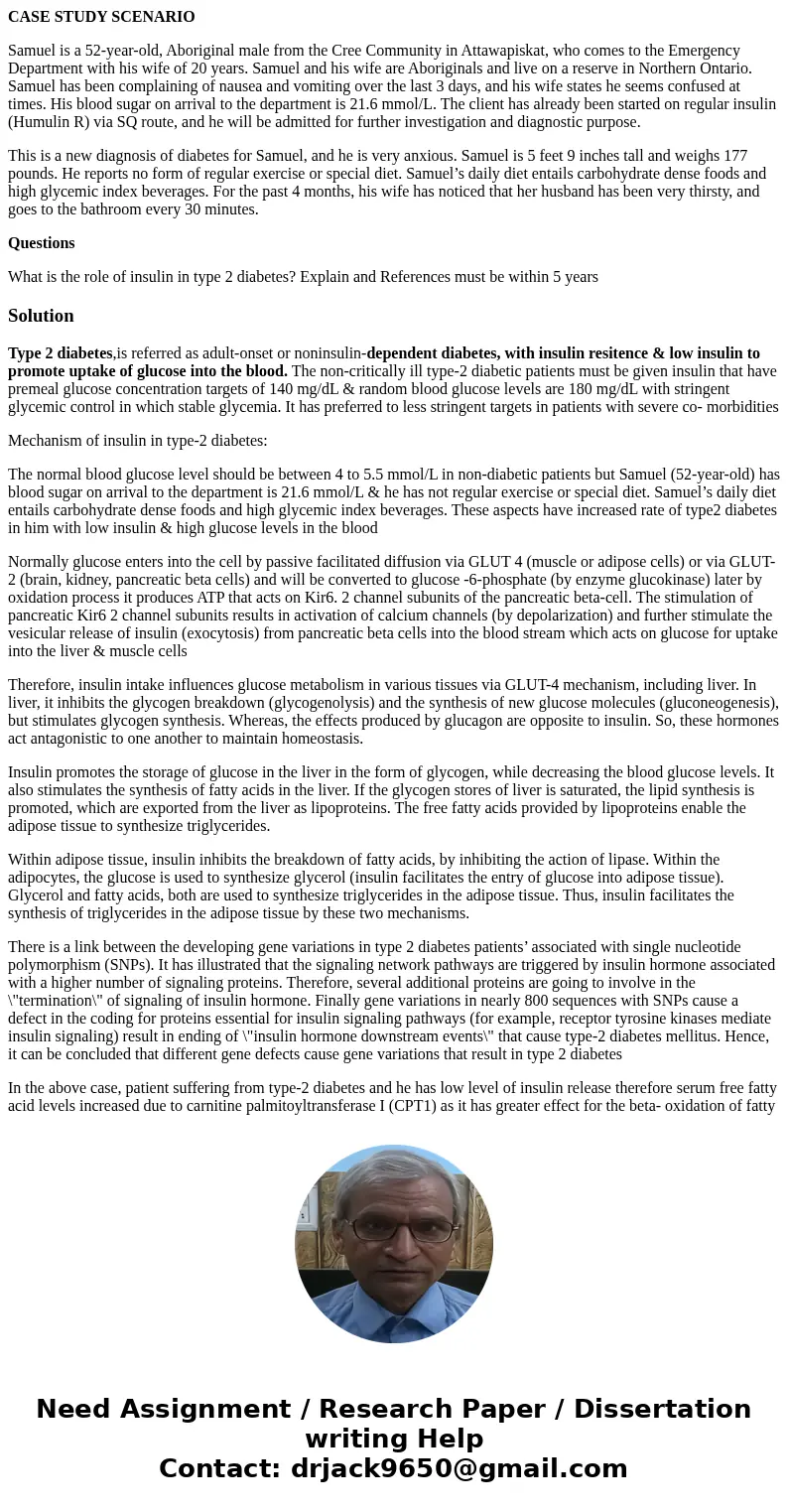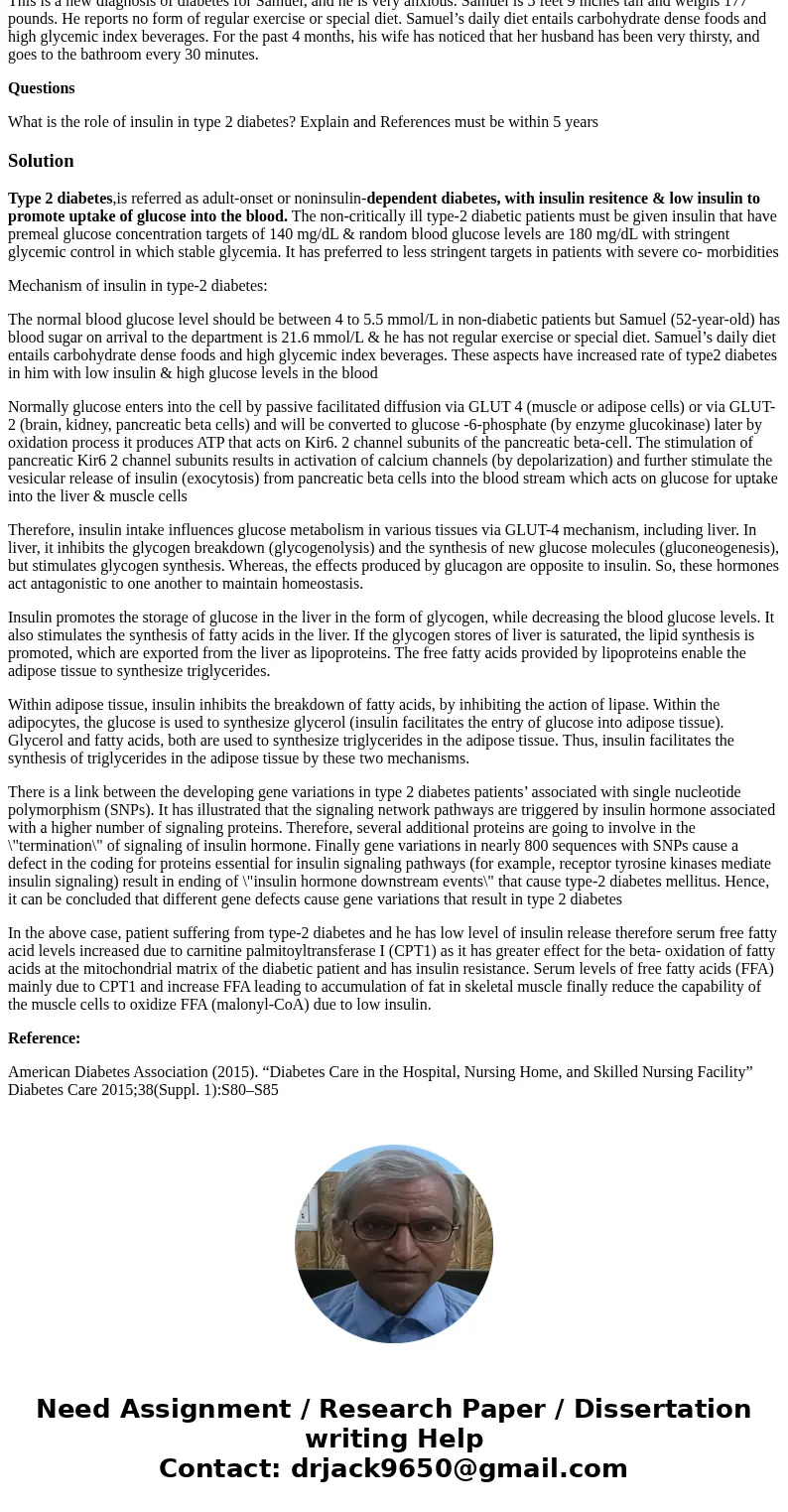CASE STUDY SCENARIO Samuel is a 52yearold Aboriginal male fr
CASE STUDY SCENARIO
Samuel is a 52-year-old, Aboriginal male from the Cree Community in Attawapiskat, who comes to the Emergency Department with his wife of 20 years. Samuel and his wife are Aboriginals and live on a reserve in Northern Ontario. Samuel has been complaining of nausea and vomiting over the last 3 days, and his wife states he seems confused at times. His blood sugar on arrival to the department is 21.6 mmol/L. The client has already been started on regular insulin (Humulin R) via SQ route, and he will be admitted for further investigation and diagnostic purpose.
This is a new diagnosis of diabetes for Samuel, and he is very anxious. Samuel is 5 feet 9 inches tall and weighs 177 pounds. He reports no form of regular exercise or special diet. Samuel’s daily diet entails carbohydrate dense foods and high glycemic index beverages. For the past 4 months, his wife has noticed that her husband has been very thirsty, and goes to the bathroom every 30 minutes.
Questions
What is the role of insulin in type 2 diabetes? Explain and References must be within 5 years
Solution
Type 2 diabetes,is referred as adult-onset or noninsulin-dependent diabetes, with insulin resitence & low insulin to promote uptake of glucose into the blood. The non-critically ill type-2 diabetic patients must be given insulin that have premeal glucose concentration targets of 140 mg/dL & random blood glucose levels are 180 mg/dL with stringent glycemic control in which stable glycemia. It has preferred to less stringent targets in patients with severe co- morbidities
Mechanism of insulin in type-2 diabetes:
The normal blood glucose level should be between 4 to 5.5 mmol/L in non-diabetic patients but Samuel (52-year-old) has blood sugar on arrival to the department is 21.6 mmol/L & he has not regular exercise or special diet. Samuel’s daily diet entails carbohydrate dense foods and high glycemic index beverages. These aspects have increased rate of type2 diabetes in him with low insulin & high glucose levels in the blood
Normally glucose enters into the cell by passive facilitated diffusion via GLUT 4 (muscle or adipose cells) or via GLUT-2 (brain, kidney, pancreatic beta cells) and will be converted to glucose -6-phosphate (by enzyme glucokinase) later by oxidation process it produces ATP that acts on Kir6. 2 channel subunits of the pancreatic beta-cell. The stimulation of pancreatic Kir6 2 channel subunits results in activation of calcium channels (by depolarization) and further stimulate the vesicular release of insulin (exocytosis) from pancreatic beta cells into the blood stream which acts on glucose for uptake into the liver & muscle cells
Therefore, insulin intake influences glucose metabolism in various tissues via GLUT-4 mechanism, including liver. In liver, it inhibits the glycogen breakdown (glycogenolysis) and the synthesis of new glucose molecules (gluconeogenesis), but stimulates glycogen synthesis. Whereas, the effects produced by glucagon are opposite to insulin. So, these hormones act antagonistic to one another to maintain homeostasis.
Insulin promotes the storage of glucose in the liver in the form of glycogen, while decreasing the blood glucose levels. It also stimulates the synthesis of fatty acids in the liver. If the glycogen stores of liver is saturated, the lipid synthesis is promoted, which are exported from the liver as lipoproteins. The free fatty acids provided by lipoproteins enable the adipose tissue to synthesize triglycerides.
Within adipose tissue, insulin inhibits the breakdown of fatty acids, by inhibiting the action of lipase. Within the adipocytes, the glucose is used to synthesize glycerol (insulin facilitates the entry of glucose into adipose tissue). Glycerol and fatty acids, both are used to synthesize triglycerides in the adipose tissue. Thus, insulin facilitates the synthesis of triglycerides in the adipose tissue by these two mechanisms.
There is a link between the developing gene variations in type 2 diabetes patients’ associated with single nucleotide polymorphism (SNPs). It has illustrated that the signaling network pathways are triggered by insulin hormone associated with a higher number of signaling proteins. Therefore, several additional proteins are going to involve in the \"termination\" of signaling of insulin hormone. Finally gene variations in nearly 800 sequences with SNPs cause a defect in the coding for proteins essential for insulin signaling pathways (for example, receptor tyrosine kinases mediate insulin signaling) result in ending of \"insulin hormone downstream events\" that cause type-2 diabetes mellitus. Hence, it can be concluded that different gene defects cause gene variations that result in type 2 diabetes
In the above case, patient suffering from type-2 diabetes and he has low level of insulin release therefore serum free fatty acid levels increased due to carnitine palmitoyltransferase I (CPT1) as it has greater effect for the beta- oxidation of fatty acids at the mitochondrial matrix of the diabetic patient and has insulin resistance. Serum levels of free fatty acids (FFA) mainly due to CPT1 and increase FFA leading to accumulation of fat in skeletal muscle finally reduce the capability of the muscle cells to oxidize FFA (malonyl-CoA) due to low insulin.
Reference:
American Diabetes Association (2015). “Diabetes Care in the Hospital, Nursing Home, and Skilled Nursing Facility” Diabetes Care 2015;38(Suppl. 1):S80–S85


 Homework Sourse
Homework Sourse